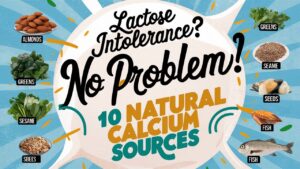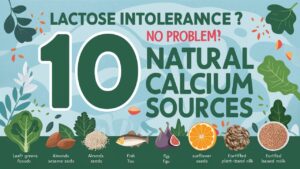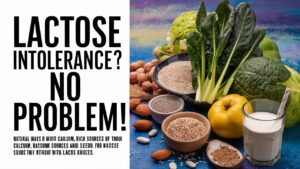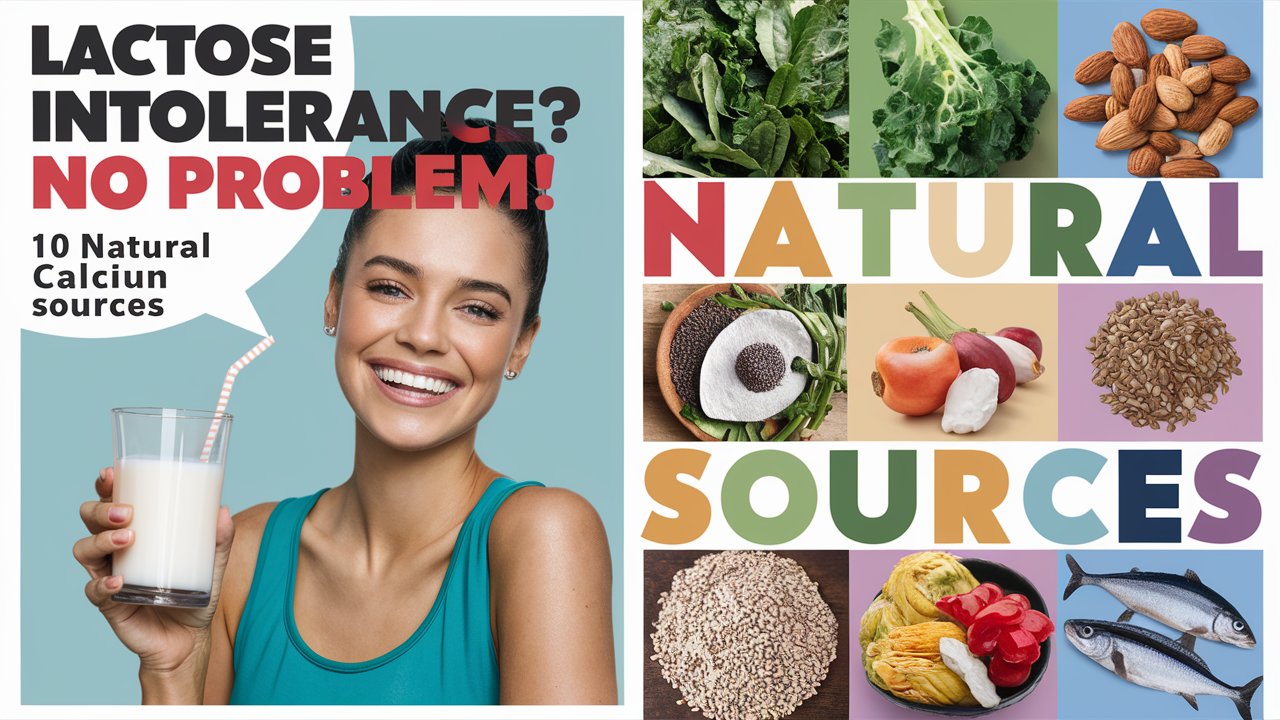Lactose intolerance is a commonplace condition where people can’t digest lactose, the sugar found in milk and dairy merchandise. Calcium is crucial for keeping healthy bones and enamel, muscle feature, and nerve signaling. However, for folks that are lactose intolerant, acquiring sufficient calcium can be difficult without dairy merchandise. This article targets to offer precious statistics on natural, dairy-free assets of calcium and the way to include them into your food plan.
Types and Categories of Lactose Intolerance
Primary Lactose Intolerance
Primary lactose intolerance is the most common type, in which the body’s potential to provide lactase, the enzyme that breaks down lactose, decreases with age.
Secondary Lactose Intolerance
Secondary lactose intolerance takes place because of an contamination or damage affecting the small intestine, along with celiac sickness or Crohn’s sickness, main to decreased lactase manufacturing.
Congenital Lactose Intolerance
Congenital lactose intolerance is an extraordinary, inherited ailment in which toddlers are born with very little lactase enzyme.
Developmental Lactose Intolerance
Developmental lactose intolerance can arise in premature toddlers but commonly improves through the years because the little one matures.
Symptoms and Signs of Lactose Intolerance

Common Symptoms
- Bloating
- Diarrhea
- Gas
- Stomach cramps
Severe Symptoms
- Nausea
- Vomiting
- Severe abdominal ache
Differentiating from Other Digestive Issues
Lactose intolerance signs and symptoms can overlap with different digestive problems, which include irritable bowel syndrome (IBS) or small intestinal bacterial overgrowth (SIBO). Accurate analysis is vital for correct control.
Causes and Risk Factors
Genetic Factors
Lactose intolerance is often inherited, with genetic predispositions being a tremendous element.
Ethnic Predisposition
Certain ethnic organizations, consisting of the ones of East Asian, West African, Arab, Jewish, Greek, and Italian descent, have higher charges of lactose intolerance.
Age-Related Factors
Lactase manufacturing decreases clearly with age, making older adults more liable to lactose intolerance.
Other Health Conditions
Conditions that affect the small gut, including celiac disorder, Crohn’s sickness, and gastroenteritis, can lead to secondary lactose intolerance.
Diagnosis and Tests
Lactose Tolerance Test
Measures the body’s glucose reaction after consuming lactose, indicating how properly the body can digest lactose.
Hydrogen Breath Test
Measures the amount of hydrogen inside the breath after consuming lactose, with high tiers indicating lactose intolerance.
Stool Acidity Test
Used for infants and young children, this take a look at measures the acidity in stool samples, with excessive acidity indicating undigested lactose.
Elimination Diet
Involves putting off lactose-containing ingredients from the diet to see if signs and symptoms improve, followed through a slow reintroduction to pinpoint the intolerance.
Treatment Options
Dietary Adjustments
Eliminating or reducing lactose-containing ingredients and changing them with lactose-free options.
Lactase Enzyme Supplements
Over-the-counter dietary supplements that help digest lactose whilst taken before ingesting dairy.
Probiotics
Certain probiotics can improve lactose digestion by using improving the intestine flora.
Calcium and Vitamin D Supplements
For those not able to satisfy their calcium needs through weight loss plan alone, supplements can be a helpful addition.
Preventive Measures
Gradual Introduction of Lactose
Some people may tolerate small quantities of lactose if brought gradually.
Dairy Alternatives
Using lactose-free dairy products and plant-primarily based options like almond milk, soy milk, and coconut yogurt.
Nutritional Planning
Working with a dietitian to ensure a balanced weight loss plan that meets all nutritional needs without dairy.
Regular Medical Check-Ups
Monitoring bone density and basic health with normal scientific visits to save you headaches from calcium deficiency.
Personal Stories or Case Studies
Real-Life Experiences of Managing Lactose Intolerance
Personal stories from people who’ve efficaciously managed their lactose intolerance through dietary changes.
Success Stories with Dietary Changes
Accounts of people who have determined effective ways to include dairy-loose calcium resources into their diets.
Challenges Faced and How They Were Overcome
Insights into commonplace demanding situations confronted by way of people with lactose intolerance and practical solutions.
Expert Insights
Quotes from Nutritionists
“Many plant-based totally meals are brilliant resources of calcium. Including a variety of these for your food regimen can help ensure you meet your calcium needs.” – Jane Doe, RD
Advice from Gastroenterologists
“Proper diagnosis and individualized remedy plans are key to dealing with lactose intolerance successfully.” – Dr. John Smith, MD
Insights from Dietitians
“Calcium-fortified foods and drinks can be a convenient way to boost calcium intake for the ones warding off dairy.” – Mary Johnson, RD
10 Natural Dairy-Free Sources of Calcium

Leafy Greens (Kale, Collard Greens)
Rich in calcium, those vegetables are also filled with vitamins and minerals.
Almonds
A exquisite snack that gives calcium together with healthful fat and protein.
Chia Seeds
High in calcium, omega-3 fatty acids, and fiber, chia seeds may be delivered to smoothies, yogurts, and baked items.
Fortified Plant Milks (Soy, Almond)
These liquids are frequently fortified with calcium and nutrition D, making them superb dairy alternatives.
Tofu
Calcium-set tofu is a versatile and nutrient-dense food that can be utilized in numerous dishes.
Broccoli
This cruciferous vegetable is a good supply of calcium and other crucial vitamins.
Figs
Dried figs are a sweet and calcium-wealthy snack alternative.
White Beans
These legumes are high in calcium, protein, and fiber, making them a healthy addition to soups and salads.
Oranges
In addition to being high in diet C, oranges offer a good amount of calcium.
Sesame Seeds
Rich in calcium, sesame seeds may be sprinkled on salads, stir-fries, and baked items.
Health Benefits of Natural Calcium Sources
Bone Health
Calcium is crucial for keeping sturdy bones and preventing osteoporosis.
Muscle Function
Calcium performs a vital function in muscle contraction and relaxation.
Cardiovascular Health
Adequate calcium intake enables hold heart rhythm and blood strain.
Other Benefits
Calcium supports nerve function, hormone launch, and blood clotting.
How to Incorporate These Sources Into Your Diet

Meal Planning Tips
Create balanced meals that encompass a whole lot of calcium-rich ingredients.
Recipes and Snack Ideas
- Smoothies with chia seeds and fortified plant milk
- Salads with leafy veggies, almonds, and sesame seeds
- Tofu stir-fry with broccoli and white beans
Combining Sources for Optimal Intake
Pairing exclusive calcium-wealthy foods can assist make sure you meet your day by day necessities.
Common Misconceptions About Calcium and Dairy-Free Diets
Myth: Only Dairy Provides Sufficient Calcium
Many plant-based foods are rich in calcium and may meet day by day necessities.
Myth: Dairy-Free Diets Are Always Deficient in Calcium
With proper making plans, a dairy-free eating regimen can offer all essential vitamins, such as calcium.
Myth: Calcium Supplements Are Always Necessary
While supplements can assist, they are now not usually required if you consume lots of calcium-rich ingredients.
In summary, lactose intolerance does now not suggest you have to omit out on crucial nutrients like calcium. There are lots of natural, dairy-unfastened sources of calcium that can be effortlessly included into your food regimen. By exploring those options, you can make certain your body gets the calcium it needs for most desirable health. For further schooling and personalized advice, do not forget consulting a healthcare expert.
From Chronological to Biological Age : The New Way to Understand Your Health 2024
Holly Logan’s 90-Pound Weight Loss Story : From Stage to Strength
The Story of Obesity and Depression Together : Breaking the Cycle:
Are Tampons Safe? Understanding the Risks and Safety Measures

1 thought on “Lactose Intolerance? 10 Natural Calcium Sources to Keep You Healthy”